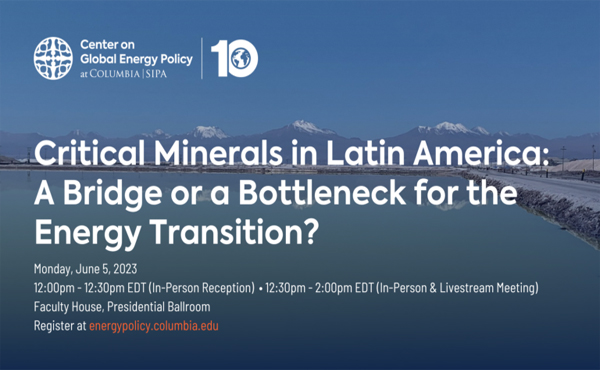- Region has world’s largest deposits of copper, lithium
- Social, political, environmental challenges could slow transition

Justine Coyne, Platts S&P Global
PITTSBURGh, Pensylvania
Energiesnet.com 06 06 2023
Latin America, with the world’s largest deposits of both copper and lithium, is critical to the global energy transition, but the region faces social, political, environmental and financial challenges to increase mineral extraction and processing capacity to what is needed, panelists discussed June 5 at an event Columbia University’s Center on Global Energy Policy hosted
Latin American production of copper and lithium will decide on the pace of transition, according to Tom Moerenhout, a research scholar at the Center on Global Energy Policy.
He noted that while American countries have a very high share of lithium reserves, the region has a much lower share of global lithium production. With the increased shift to electric vehicles, it is projected that North American lithium demand will face a 12.5% deficit by the end of this decade.
“These are huge numbers,” Moerenhout said. “When you worry about fluctuating prices and increasing prices, you have that effect when you have a tight market with potential supply deficits, which is where we are at today. So, imagine a 12.5% deficit that is going to be passed through in battery costs and electric vehicle costs.”
Latin American lithium in particular is important as it is produced from brine, which is much more easily processed into lithium carbonate, which goes into lithium-ion phosphate batteries, Moerenhout noted.
“These batteries are cheaper, they are safer and very important to [the] energy transition,” he said.
Looking at the copper market, a 15%-20% supply deficit is expected by 2030, according to S&P Global research.
“Keep in mind, when you have a supply deficit, your price goes up and your markets react,” Moerenhout said.
Building new mines, however, takes at least 10 years with the average for critical mineral mines in recent decades standing at 16 years, he said, attributing the data to the International Energy Agency. “Even if your market responds, and it will, the response will be slow,” he said.
Environmental and social challenges
María José Baptista, interagency and intergovernmental affairs officer for the United Nations Environment Programme, said as Latin American countries ramp up production of critical minerals to meet growing needs, countries need to create safeguards for people and the environment.
She pointed to Bolivia as an example. The country has 21 million mt of lithium, more than any other country in the world, but produced less than 1% of global supply in 2021. “There’s a lot of potential there, but how to do this in a way that will benefit locals that will protect the environment? It’s a difficult task,” she said.
Most of the developing countries in Latin America are already commodity-dependent, so Baptista said there is a need to move beyond just depending on extraction.
“We want this new mineral boom to actually be an opportunity to diversify, to get into other industries, so that when the mine closes, people have other livelihoods, people can carry on and actually the site is not completely ruined,” she said. “These countries need to think about how to move into the other stages of the value chain and not become only a mere extractor.”
Policy challenges
Governments are looking to take advantage of opportunities brought on by the energy transition to benefit their countries long term.
In the case of Chile, it represents 36% of global lithium reserves and 23% of global copper reserves, said Juan Carlos Jobet, distinguished visiting fellow at the Center on Global Energy Policy and former minister of energy and mining for Chile.
“Without mining, there is no energy transition. Full stop,” Jobet said. “… So whatever happens in Chile, in mining is very important for the energy transition…if the country that produces 30% of the world’s copper slows down production, the impact that’s going to have on price, and then the adoption of green technology is going to be huge.”
After tripling production from 1990 to 2004, Chile’s copper output has remained relatively flat as grades of deposits have gone down, costs have gone up, and getting water is increasingly difficult. Jobet noted that in the case of copper, most of the increased production seen in recent years has come from private companies and not state-owned Codelco. “I mention this because there is a wave of kind of mining nationalism … in Latin America,” Jobet said.
Under Chile’s National Lithium Strategy, which President Gabriel Boric launched in late April, the country aims to take a controlling stake in the operations on the Salar de Atacama, estimated to contain 40% of the world’s lithium reserves.
Jobet said he agrees with the goals of increased lithium production with low environmental impact, making sure local communities capture a fair share of the benefits, and trying to push the industry to add more value, however, he does not agree with the approach.
“They are saying that all lithium production, I mean projects or companies, should be controlled by the state, and I am skeptical about state-owned enterprises playing a key role in the development of the industry,” he said. “…We don’t have a very good track record of state-owned companies developing projects in an efficient way.”
The second issue is the risk-reward challenge this creates for private investors looking to invest, Jobet said.
“The risk-return equation they are offering to private investors is not very attractive,” he said. “…The essence of exploration in mining is that I take a big risk, because if I am successful I have the right to produce. If I take the risk of exploration, but if I’m successful I might not get the right to produce, then that’s a problem.”
spglobal.com 06 05 2023












